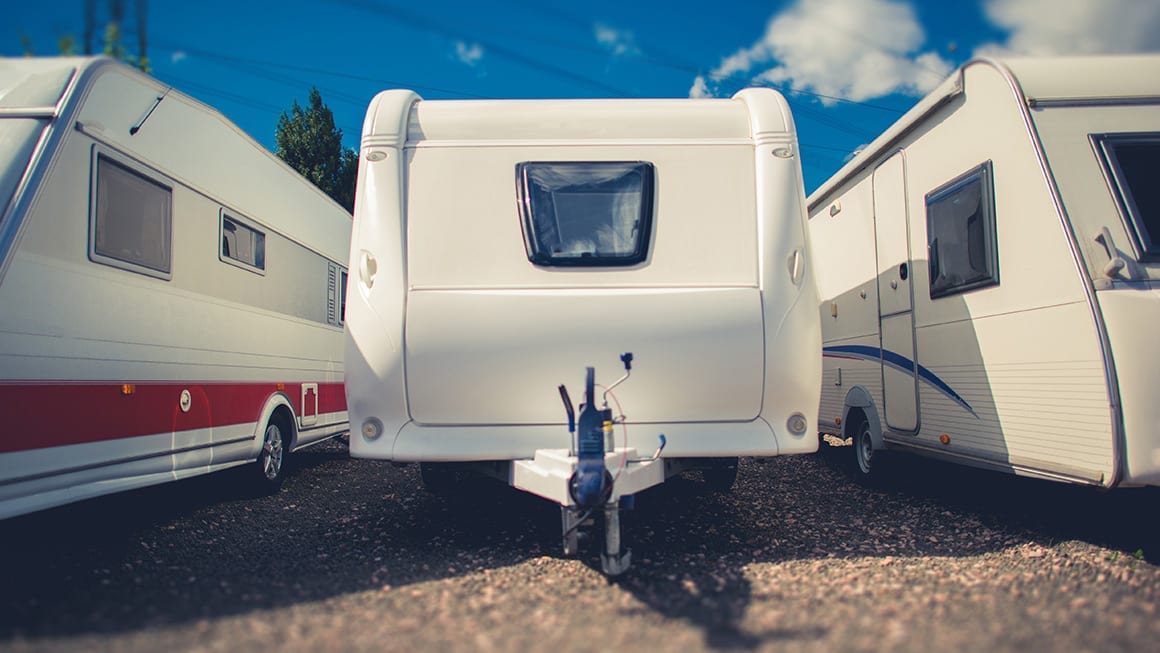Follow These Tips for Winterizing a Boat or RV This Fall
Once again, that old familiar chill is
But while you’re enjoying the fall foliage and pumpkin spice, don’t forget to prepare your boat or RV for the cold weather ahead.
Boats and campers are at high risk of water and ice damage when temperatures fall. Winterizing today will save you big headaches when springtime rolls back around.
How to Winterize Your Boat
For all boats, check your owner’s manual for specific instructions for
Plumbing
Water that freezes inside your boat’s plumbing system will cause pumps, hoses or water fixtures to break. Draining and treating your system with non-toxic antifreeze reduces the risk
Freshwater systems. Open all faucets until the system is completely empty, then add non-toxic antifreeze to the holding tank. Reopen all faucets to be sure the antifreeze comes out. 2- Raw water systems. Drain
washdowns andlivewells , and treat with antifreeze. 1 - Sanitation. Empty the holding tank at a pumpout facility, and thoroughly flush with fresh water. Fill with antifreeze
. 1
Outboard Engines
If possible, run the outboard engine every few weeks during the winter
- Tilt it all the way down, change the oil and inspect for water damage
. 2 - Flush the cooling system with fresh water and change the fuel and oil filters
. 1 - Fog the engine with fogging oil
. 1 - Take care of any other services recommended by your manufacturer
. 1
Consult your owner’s manual for instructions on corrosion prevention and which products to use
Inboard Engines & Sterndrives
Ice will damage inboard engines and
- Drain the inboard engine and run antifreeze through the system. Follow up with a fogging treatment and oil change. Inspect for parts in need of repair or replacement
. 2 - For
sterndrives , remove all water from the engine block and drive unit before treating with antifreeze. Treat with fogging oil, change the oil and inspect for wear and tear.2 Change the gear lube in the lower unit.1
Fuel System & Batteries
Leaving old fuel in your tank for several months is a bad idea, as is letting the battery sit idle for too long.
- If your boat will be idle for several months, run the fuel level as low as possible and treat any remaining fuel with stabilizer. Change fuel filters.1
- For the battery, use a trickle charge all winter long. Options include hooking it up at home, plugging it in at a boatyard, or using a solar charger.1
Storing & Covering Your Boat
Smaller boats are easier to store on land, while some larger boats will need to stay in the water. Leaving your boat in the water increases the risk of damage from water, ice, corrosion and other hazards.1 If your boat will stay in the water all winter long, take the following steps to protect it:2
- Close seacocks.
- Check rudder shafts and stuffing boxes for leaks.
- Make sure the battery is fully charged.
- Clean terminals and add water if needed to ensure system is working.
- Check bilge pumps, and make sure float switches work.
- Monitor boat throughout the season for leaks, pests.
- If your mooring area is likely to freeze, suspend water agitators below to bring warm water to the surface, to reduce risk of icing.
If you’ll be storing your boat on land, be sure to clean, pressure-wash and wax the hull. While you’re at it, inspect the hull for signs of damage. Clean through-hulls and strainers, and open seacocks to drain.
You also have a few options for covering your boat:1
- Plastic tarp is your least expensive option. However, it doesn’t last as long, often flaps in strong winds and may not fit properly.
- A canvas tarp is heavier and does a better job of staying put in windy weather. It also lasts longer. This option is more expensive, and you’ll need a solid frame to support the extra weight.
- A fitted cover is the most expensive option, but tends to last the longest and can be pre-fitted for an exact match.
Finally, a little housekeeping is in order. Remove personal items including food, sunscreen, fishing gear, clothing and linens. Clean and dry all parts to avoid damage from dirt and grime.1
How to Winterize Your RV
As with your boat, review your owner’s manual for model-specific winterization instructions, and see a professional service provider if you have questions.
Plumbing
Drain your RV’s plumbing system and treat with antifreeze.3
- Remove and bypass water filters to protect them from damage by winterization chemicals.
- Drain black and gray water tanks, and clean the black tank with a cleaning wand and cleaner.
- Open all faucets and let all water drain out of the water lines. Drain the water heater.
- Bypass your water heater, as antifreeze will damage it. Some RVs have a bypass feature built in, while others can have one installed.
- Close all faucets and drain lines, and turn on the pump to run antifreeze through the system. Reopen all faucets to make sure antifreeze runs through them.
Engine & Batteries
Next, turn your attention to your RV’s engine and batteries.4
- Top off the fuel tank and add an engine stabilizer. Treat the radiator with antifreeze. Check the oil, brake fluid and windshield washer solution.
- Fully charge the battery and top off fluid levels. Store the battery in a dry location, below freezing, and disconnect cables for safety.
Tires
Park your RV on a level, paved surface to prevent the tires from sinking into the ground.4
- Use jacks to raise the camper off of the ground and relieve pressure on the tires.4
- If you don’t have access to any jacks, move the RV about ½ tire rotation 1-2 times during the winter to redistribute the weight.4
- Apply tire covers to prevent dry rot.5
Electrical & Propane
Increase safety and efficiency by winterizing elecrical systems and propane tanks.4
- Turn off the main circuit breaker.
- Disconnect the RV from shore power.
- Remove batteries from clocks, alarms, radios and detectors.
- Protect the exhaust from pests by blocking it with steel wool or aluminum foil.
- Fill all propane tanks.
- Remove and store propane tanks in a sheltered location but not inside the RV.
- Cover the propane tank connections to keep pests out.
Interior
Take some time to clean the inside of your RV to avoid a messy, smelly surprise come springtime.4
- Remove personal belongings like food and drinks, clothing and linens, valuables, electronics and toiletries.
- Clean and vacuum.
- After emptying the freezer, leave it thawed and dry. Prop open the refrigerator door and open a fresh container of baking soda for season-long freshness.
- Check for openings or cracks where pests may enter, and seal or cover them. Close all vents.
- To protect against moisture, mold and mildew, open a fresh container of moisture absorbent and place it on a flat surface.
Exterior
Keep your RV in good condition by tending to the exterior.
- Wash and wax your RV. Clean the awning4, and remove debris from the side and seams.5
- Seal doors, windows, vents and storage compartments, and inspect for damage5. Seal with caulk if necessary.4
- Clean and store the sewer hose, and place bumper caps in their proper position.4
Cover & Store
Park your RV with the emergency brake and use wheel chocks. You have a few options for storing your RV:6
At-home options:
- Your driveway or backyard offers convenience and low cost. Disadvantages include exposure to bad weather, a higher risk of theft or vandalism and HOA restrictions. If you choose to enlarge your driveway or construct a paved backyard surface, you may also be subject to HOA restrictions or local regulations.
- Your garage offers convenience with a lower risk from bad weather, vandalism and theft. If you have enough room, you could also have a customized RV garage installed on your property.
Storage facility options:
- Outdoor storage offers low cost along with security features like high fences, keypad entry and video surveillance. However, your RV will still be exposed to bad weather.
- Covered storage gives you better protection from rain and snow, but your RV will still be vulnerable to extreme temperatures and high winds.
- Indoor storage gives you the best protection from extreme weather conditions and security risks, but is the most expensive storage option.
By taking the time to prepare your boat or RV for winter, you’ll have fewer problems to deal with when warm weather returns — so you can spend less time and money on costly repairs, and more time having fun!
Do you need insurance for your boat or RV?
Contact The Resource Center and we’ll help you select the best policy to meet your needs.
Get a quote here
Sources:
1: https://www.boats.com/how-to/how-to-winterize-a-boat/.
2: https://www.discoverboating.com/ownership/storage/winterizing.
3: https://blog.campingworld.com/rv-basics/how-to-winterize-your-rv/.
4: https://www.reserveamerica.com/outdoors/how-to-winterize-an-rv.htm.
5: https://blog.campersinn.com/blog/14-tips-for-winterizing-your-rv.







